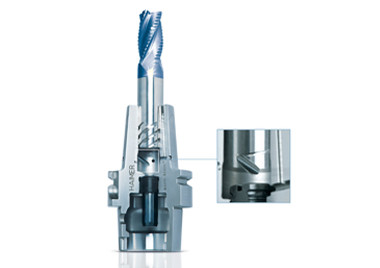
Cutting tool maker SGS Tool Co., Munroe Falls, Ohio, recently signed a licensing agreement with Haimer GmbH, Igenhausen, Germany, for the tool holding company's HAIMER Safe-Lock System, according to a recent news release.
SGS Tool, a market leader for solid carbide end mills in North America, has begun offering their high quality cutting tools with the HAIMER Safe-Lock System. The unique Safe-Lock design in cutting tools and tool holders combines high-precision, shrink-fit clamping with a positive form locking mechanism.
According to Haimer, this prevents round cutting tools from being rotated or completely pulled out from tool holders during heavy machining. The combination of a symmetrical locking tool design with high concentricity and excellent balance of the Safe-Lock system is said to produce a vibration-free machining process, which the company said leads to more efficient metal removal rates—superior to that of conventional milling chucks or Weldon side-lock tool holders.
"In our testing," said David Byrley, SGS Tool's vice president of business development, "we have clearly seen a comprehensive advantage of Safe-Lock in comparison to other systems.” Byrley cited that testing and an increasing demand in the North American market that SGS cutting tools offer the Safe-Lock grooves on the shank.
"The Safe-Lock design has been established as the global standard for anti pull-out," Byrley added.
Brendt Holden, president of Haimer USA stated: "We are very pleased to have entered into this agreement with a company the caliber of SGS. The innovative flute geometries pioneered by SGS in our industry lend themselves perfectly for the Safe-Lock System. I am confident that the loyal SGS customer base will welcome this technology as a resource to be used to greatly increase their productivity on the shop floor."
Related Glossary Terms
- conventional milling ( up milling)
conventional milling ( up milling)
Cutter rotation is opposite that of the feed at the point of contact. Chips are cut at minimal thickness at the initial engagement of the cutter’s teeth with the workpiece and increase to a maximum thickness at the end of engagement. See climb milling.
- gang cutting ( milling)
gang cutting ( milling)
Machining with several cutters mounted on a single arbor, generally for simultaneous cutting.
- milling
milling
Machining operation in which metal or other material is removed by applying power to a rotating cutter. In vertical milling, the cutting tool is mounted vertically on the spindle. In horizontal milling, the cutting tool is mounted horizontally, either directly on the spindle or on an arbor. Horizontal milling is further broken down into conventional milling, where the cutter rotates opposite the direction of feed, or “up” into the workpiece; and climb milling, where the cutter rotates in the direction of feed, or “down” into the workpiece. Milling operations include plane or surface milling, endmilling, facemilling, angle milling, form milling and profiling.
- shank
shank
Main body of a tool; the portion of a drill or similar end-held tool that fits into a collet, chuck or similar mounting device.







